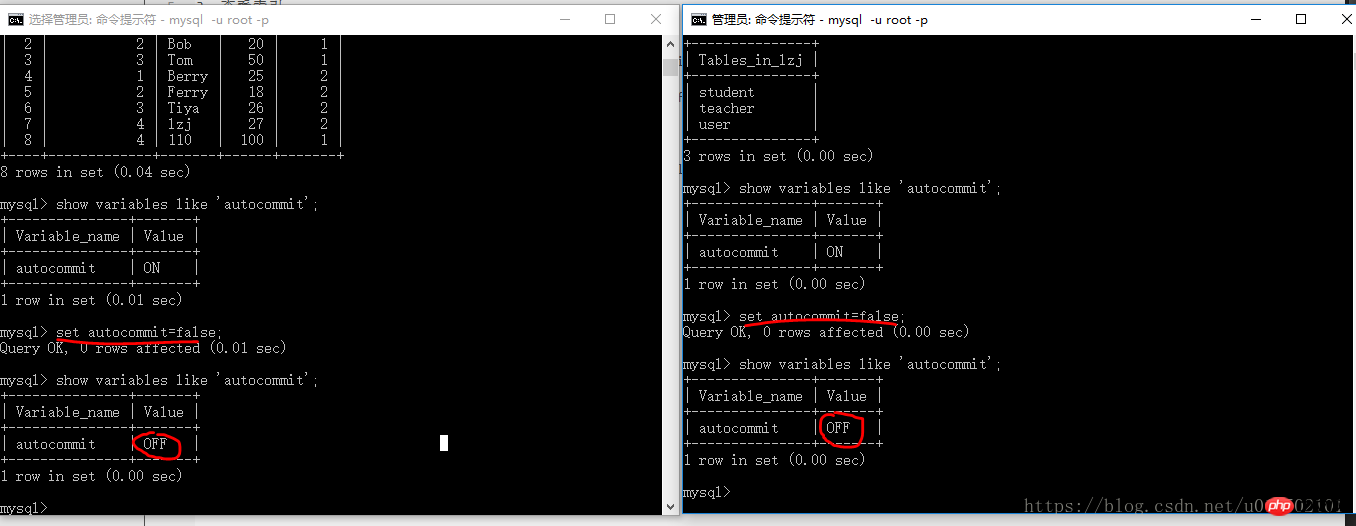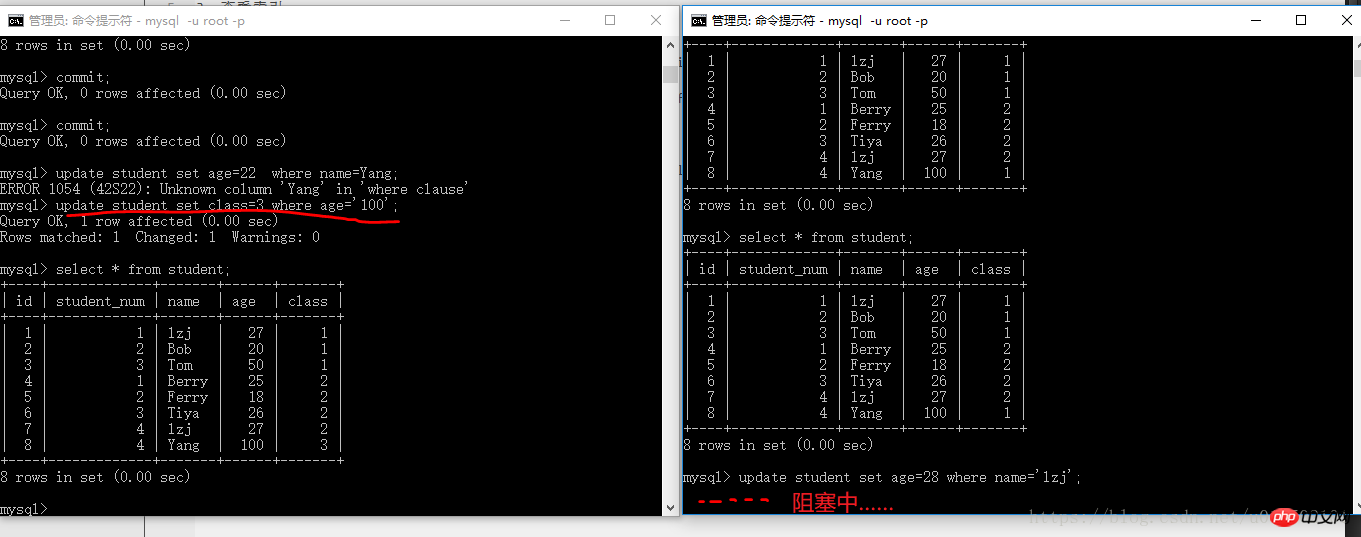MySql type conversion causes row lock to be upgraded to table lock
In the write statement of MySql, when the value assigned to the table column does not match the table type, the underlying optimizer of MySql will take effect and perform a forced type conversion. At this time, the operation can be normal, but the row lock will be upgraded to the table Lock. The example is as follows
Take the student table as an example, the table field type:  The table content is as follows:
The table content is as follows: 
Open two session windows, And change the automatic submission mode of MySql in the two session windows to manual submission
>set autocommit=false;
 Execute the update statement in session window 1, but do not commit the transaction. The age column is specified as int type when creating the table. The string '100' is used for assignment in the update statement. The MySql optimizer will automatically convert the string '100' into an integer 100, and then perform the SQL retrieval. .
Execute the update statement in session window 1, but do not commit the transaction. The age column is specified as int type when creating the table. The string '100' is used for assignment in the update statement. The MySql optimizer will automatically convert the string '100' into an integer 100, and then perform the SQL retrieval. .
>update student set class=3 where age='100'
Then perform update operations on other irrelevant data in session window 2
>update student set age=28 where name='lzj';
Under normal circumstances, the row data operated by the two SQL statements are different and will not affect each other when executed. However, The actual update operation in session 1 blocked the update operation in session 2 The update operation was performed in session 1, but the transaction submission was not executed. The isolation level of the transaction was Read Committed, so it is still seen in session 2. Less than the updated results in session 1. However, when performing data update operations on other rows in Session 2, blocking occurred. It can be seen that the assignment of the SQL statement in session 1 was forced, causing the row lock in session 1 to be upgraded to a table lock, locking the entire student table, and thus the SQL in session 2 was blocked. Next, perform a transaction commit on the update operation in session 1, then the update operation in session 2 will continue to be executed.
The update operation was performed in session 1, but the transaction submission was not executed. The isolation level of the transaction was Read Committed, so it is still seen in session 2. Less than the updated results in session 1. However, when performing data update operations on other rows in Session 2, blocking occurred. It can be seen that the assignment of the SQL statement in session 1 was forced, causing the row lock in session 1 to be upgraded to a table lock, locking the entire student table, and thus the SQL in session 2 was blocked. Next, perform a transaction commit on the update operation in session 1, then the update operation in session 2 will continue to be executed. Execute the update operation in session 1
Execute the update operation in session 1commitAfter manually submitting the transaction , session 1 releases the student's table lock, and the update operation in session 2 can continue to be executed.
Finally, commit transaction submission is also executed for the update in session 2. Both SQLs are updated. The content of the student table is as follows:
From the above case view It is known that when the SQL statement assignment does not match the table column type, MySql's optimizer is forced to convert it to a matching type, causing the row lock to be upgraded to a table lock. Therefore, you must pay attention to type matching during development to avoid row locks being upgraded to table locks, which will affect concurrency performance.
Related recommendations:
Detailed introduction to MySQL row-level locks, table-level locks, and page-level locks
MySQL lock usage table-level lock
The above is the detailed content of MySql type conversion causes row lock to be upgraded to table lock. For more information, please follow other related articles on the PHP Chinese website!

Hot AI Tools

Undresser.AI Undress
AI-powered app for creating realistic nude photos

AI Clothes Remover
Online AI tool for removing clothes from photos.

Undress AI Tool
Undress images for free

Clothoff.io
AI clothes remover

Video Face Swap
Swap faces in any video effortlessly with our completely free AI face swap tool!

Hot Article

Hot Tools

Notepad++7.3.1
Easy-to-use and free code editor

SublimeText3 Chinese version
Chinese version, very easy to use

Zend Studio 13.0.1
Powerful PHP integrated development environment

Dreamweaver CS6
Visual web development tools

SublimeText3 Mac version
God-level code editing software (SublimeText3)

Hot Topics
 MySQL: An Introduction to the World's Most Popular Database
Apr 12, 2025 am 12:18 AM
MySQL: An Introduction to the World's Most Popular Database
Apr 12, 2025 am 12:18 AM
MySQL is an open source relational database management system, mainly used to store and retrieve data quickly and reliably. Its working principle includes client requests, query resolution, execution of queries and return results. Examples of usage include creating tables, inserting and querying data, and advanced features such as JOIN operations. Common errors involve SQL syntax, data types, and permissions, and optimization suggestions include the use of indexes, optimized queries, and partitioning of tables.
 How to open phpmyadmin
Apr 10, 2025 pm 10:51 PM
How to open phpmyadmin
Apr 10, 2025 pm 10:51 PM
You can open phpMyAdmin through the following steps: 1. Log in to the website control panel; 2. Find and click the phpMyAdmin icon; 3. Enter MySQL credentials; 4. Click "Login".
 Why Use MySQL? Benefits and Advantages
Apr 12, 2025 am 12:17 AM
Why Use MySQL? Benefits and Advantages
Apr 12, 2025 am 12:17 AM
MySQL is chosen for its performance, reliability, ease of use, and community support. 1.MySQL provides efficient data storage and retrieval functions, supporting multiple data types and advanced query operations. 2. Adopt client-server architecture and multiple storage engines to support transaction and query optimization. 3. Easy to use, supports a variety of operating systems and programming languages. 4. Have strong community support and provide rich resources and solutions.
 MySQL's Place: Databases and Programming
Apr 13, 2025 am 12:18 AM
MySQL's Place: Databases and Programming
Apr 13, 2025 am 12:18 AM
MySQL's position in databases and programming is very important. It is an open source relational database management system that is widely used in various application scenarios. 1) MySQL provides efficient data storage, organization and retrieval functions, supporting Web, mobile and enterprise-level systems. 2) It uses a client-server architecture, supports multiple storage engines and index optimization. 3) Basic usages include creating tables and inserting data, and advanced usages involve multi-table JOINs and complex queries. 4) Frequently asked questions such as SQL syntax errors and performance issues can be debugged through the EXPLAIN command and slow query log. 5) Performance optimization methods include rational use of indexes, optimized query and use of caches. Best practices include using transactions and PreparedStatemen
 How to connect to the database of apache
Apr 13, 2025 pm 01:03 PM
How to connect to the database of apache
Apr 13, 2025 pm 01:03 PM
Apache connects to a database requires the following steps: Install the database driver. Configure the web.xml file to create a connection pool. Create a JDBC data source and specify the connection settings. Use the JDBC API to access the database from Java code, including getting connections, creating statements, binding parameters, executing queries or updates, and processing results.
 How to start mysql by docker
Apr 15, 2025 pm 12:09 PM
How to start mysql by docker
Apr 15, 2025 pm 12:09 PM
The process of starting MySQL in Docker consists of the following steps: Pull the MySQL image to create and start the container, set the root user password, and map the port verification connection Create the database and the user grants all permissions to the database
 MySQL's Role: Databases in Web Applications
Apr 17, 2025 am 12:23 AM
MySQL's Role: Databases in Web Applications
Apr 17, 2025 am 12:23 AM
The main role of MySQL in web applications is to store and manage data. 1.MySQL efficiently processes user information, product catalogs, transaction records and other data. 2. Through SQL query, developers can extract information from the database to generate dynamic content. 3.MySQL works based on the client-server model to ensure acceptable query speed.
 How to install mysql in centos7
Apr 14, 2025 pm 08:30 PM
How to install mysql in centos7
Apr 14, 2025 pm 08:30 PM
The key to installing MySQL elegantly is to add the official MySQL repository. The specific steps are as follows: Download the MySQL official GPG key to prevent phishing attacks. Add MySQL repository file: rpm -Uvh https://dev.mysql.com/get/mysql80-community-release-el7-3.noarch.rpm Update yum repository cache: yum update installation MySQL: yum install mysql-server startup MySQL service: systemctl start mysqld set up booting







